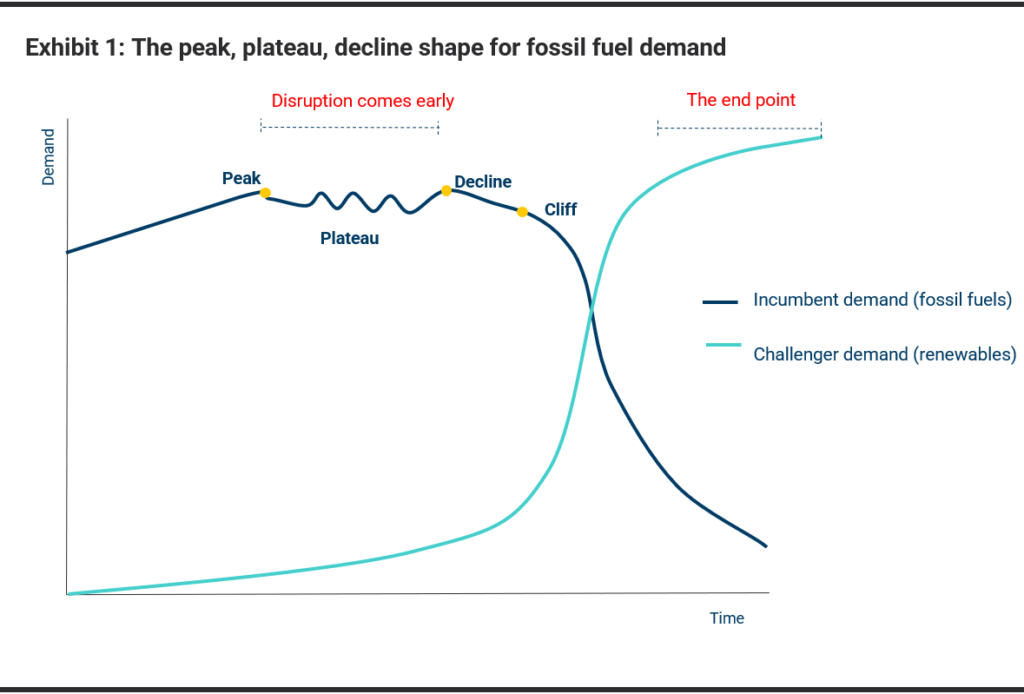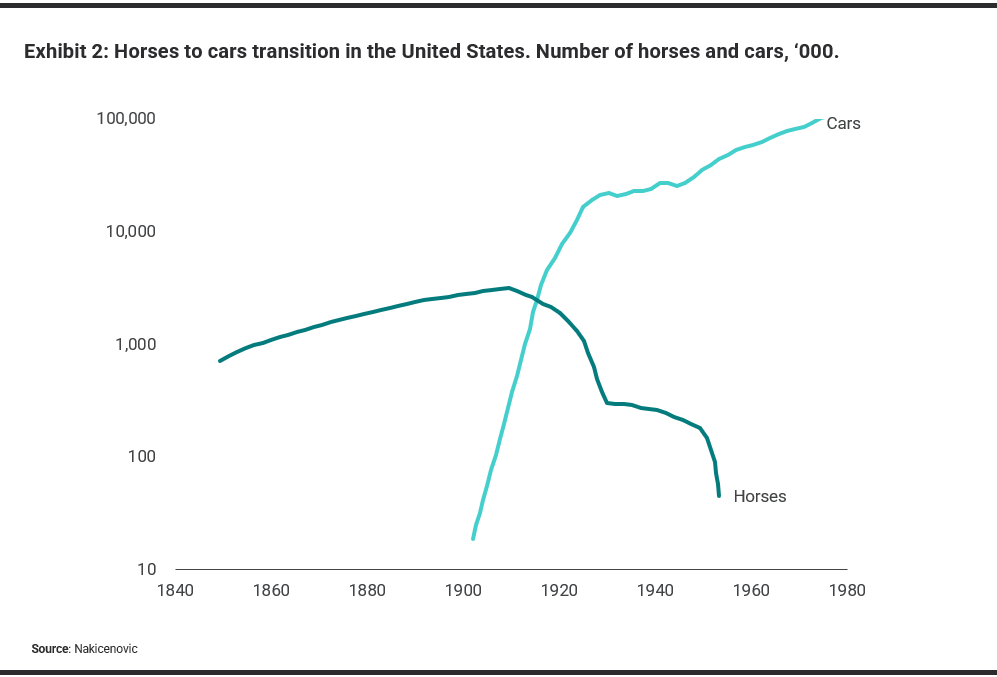
Article | 2022
Peaking: A Brief History of Select Energy Transitions
How Past Energy Transitions Foretell a Quicker Shift Away from Fossil Fuels Today
Sign-up to see new installments in our Climate Finance newsletter.
For more, see:
1. Summary
As new energy sources grow, the standard pattern of demand for existing energy sources is one of peak, plateau, and decline. In this brief, we set out the classic examples of this pattern in the past century as well as some clear examples from our own time. In most of these examples, incumbent demand peaks early in the transition, and then falls faster than it rose. Existing infrastructure enabled incumbents to resist change for a while (the plateau) but they were overwhelmed as soon as price parity was reached. This pattern repeats across the following transitions:
- Horses to cars for transport. Peak demand for horses was 1905 in the United States; within two decades demand was down by 90%.
- Gas lighting to electric lighting. Peak UK demand for gas lighting was 1907. There was a plateau until 1920. Then demand collapsed, falling 80% in the next two decades.
- Steam power to electricity. UK demand for steam power peaked around 1910, was on a plateau for around a decade, and then fell rapidly.
- Steam ships to oil ships. UK demand for steam ships peaked in 1914, bounced around on a plateau until around 1929, and then fell very fast.
- Coal heating to gas heating. UK coal demand for heating was flat after the second world war until around 1960; when cheaper gas was discovered in the North Sea, coal demand fell rapidly.
- Coal electricity to renewable electricity. The electricity shift has started in our own era. As solar and wind have entered the energy mix, OECD demand for coal electricity peaked in 2003, plateaued for about 5 years, and went into decline in 2008. Since 2008, demand has fallen by 43%.
We are now seeing massive change across the rest of the energy complex. This peak, plateau, decline pattern is spreading across sectors and geographies, from buildings to transport, and from China to the rest of the non-OECD countries. Subsequent briefs will demonstrate how this is unfolding.
2. How Energy Transitions Work
There is a huge body of academic literature on energy transitions about how long it takes to transition from one energy source to another. The consensus is clear. It takes a long time.
However, in this briefing we set ourselves a different task: to examine the impact on incumbent energy producers of the rise of new challenging technologies, with a specific focus on peak demand. Peaks matter because this is when investors sell and the balance of power starts to shift.
To put this in context of the chart below, we are hunting for the moment of the peak. The academics are either thinking about the end point or the moment when the two market shares cross.
We set out the theory of peaks in a separate article. This brief describes the empirical evidence for the pattern of peak, plateau, and decline.
As a new energy source grows, it causes demand in the old energy source to peak very early in the process of change. There is then a plateau for a few years as the old source fights back, followed by a long decline into irrelevance. The decline speeds up as soon as price parity is reached, and the speed of the decline is usually much faster than the speed of the rise.

Source: RMI
While this brief focuses on energy transitions, change is a universal phenomenon, as Heraclitus pointed out in 500 BC. Currency superseded barter; mechanical power replaced animal power; and cellular service meant the decline of land lines. This story is as old as the hills.
3. Energy Transitions of the Twentieth Century
The peak, plateau, decline pattern has been a feature of the classic energy transitions of the past. To avoid accusations of only selecting the best examples, we deliberately look at all the classic examples of the energy transition in the early twentieth century in transport, light, power, and heat, and in a single country, the UK, the leader in the old energy technologies in 1900. Similar shifts took place in other countries, and we illustrate some of these as well.
Reality itself is of course much messier than theory. There are interventions from wars and plagues, other energy sources influence the mix, and at the time the story rarely seems clear. Nevertheless, we believe that the framing is very consistent.
Land Transport: Horse to Car
The best data on the shift from horses to cars comes in fact from the United States. Car demand in the United States took off shortly after 1900, and within 5 years, the number of draft horses had peaked. Within 20 years the number of draft horses had decreased by 90%.

Source: Nakicenovic
The transition was similar in the United Kingdom. Fodder demand to feed the horses used in transportation peaked in 1902. By the time petrol appeared in the statistics in 1905, demand for fodder was already falling.
Lighting: Gas to Electric
In its day, gas lighting was a remarkable invention. In spite of the risks and cost of infrastructure, demand rose rapidly after 1850, reaching a peak in the UK in 1907.
However, it was then challenged by the rise of electricity. In its early days, electricity was dangerous, expensive and little understood. Meanwhile gas had an existing infrastructure and many pollical backers and was a well-known technology.
The result was a 13-year plateau for gas demand. Eventually, electricity became sufficiently cheap, and the technology well enough understood, that it was able to take all the growth in lighting demand. Gas demand for lighting collapsed after 1920 when electricity reached price parity.
Power: Steam to Electric
We show below demand for steam and electricity in the UK. As electricity came into the mix, steam power demand peaked around 1910, plateaued for a while, and then began a long slow decline after around 1920.
Sea Transport: Coal to Oil
The data for shipping is somewhat complicated by the intervention of the First World War, but the pattern nevertheless fits. Coal demand for shipping was rising inexorably until the war, recovered somewhat in the 1920s, and then was pushed out of the mix by oil.
Heating: Coal to Gas
Heating in the UK was once dominated by coal. After new gas reserves were found in the North Sea and gas prices fell, heating demand rapidly moved to gas.
We start the analysis at the end of the Second World War. It shows a 10–15-year plateau for coal demand, which ends as gas begins its long march upward.
4. The Present: Coal Electricity to Renewable Electricity
These changes are also taking place in our own era as the costs of renewables fall rapidly. We will look at present and looming peaks in subsequent reports, but here we present evidence of an incontrovertible peak taking place: coal demand for electricity in the OECD.
The United Kingdom
UK coal demand to generate electricity reached a peak in 2006, and the plateau lasted until 2012. As solar and wind then rose, demand has collapsed.
Europe
European demand to generate electricity from coal peaked in 2003, plateaued until 2007, and has been falling since then.
The United States
US demand for coal plateaued for about a decade after 2000 and has been falling ever since.
This pattern is not of course confined to the OECD countries. Demand for coal-based electricity has been peaking in countries across the world, from Brazil to Thailand.
5. Conclusion
These examples of energy change show that peak demand for old energy sources usually happens quickly, and often when challenging technologies have a market share of less than 5%. We also conclude the following:
- The length of the plateau varies but is usually between 1 and 10 years.
- Decline in demand for the incumbent energy technology begins in earnest as soon as the new energy technology reaches price parity. That is to say, the initial peak and most of the plateau have usually passed before price parity is achieved. This is likely because of early adopters with specific motivations and lower price points.
- The descent is usually quicker than the ascent. In other words, demand usually fell far more quickly than it rose. This makes intuitive sense. On the way up, a technology is building a market and battling efficiency gains. As soon as it loses its price advantage, incremental demand can collapse.
- Within a couple of decades of the end of the plateau, most old energy technologies are on a clear glide path into irrelevance. This is why the debate about coal demand in some distant date in the future is not the key issue; once the industry is on a descent into oblivion, the rest is noise.
This has many implications for how we think about our energy system.
- When looking at the energy system, analysts and investors should think in terms of the peak, plateau, decline framing.
- We should expect a peak when challenging technologies are small, and the incumbents still dominant.
- We should expect the peak even before average price parity is achieved.
- The end of growth for a technology is the beginning of its demise.
As we have shown in this brief, the key to understand the future is to look at the flows of new technology. When we look back, we realize that the existence of a huge installed base of horses or gas infrastructure did not protect those industries from decline. The fossil fuel system of the present stands on the cusp of this type of catastrophic decline.
Caveats
There are important caveats from this summary:
- We have not taken a scientific look at every energy transition in history. Our purpose is to illustrate the nature of the peak, plateau, decline pattern in history. And by looking at the major transitions in a single country we feel we have been quite comprehensive.
- We have looked at an individual country. As we will set out in subsequent reports, total demand is simply the addition of demand from individual countries. And that process too leads to peaks for fossil fuels.
- We have looked at end-use sectors. Total demand is the combination of end-use sectors, and when there are superior alternative sources in each of them you will get peaking demand for the whole.